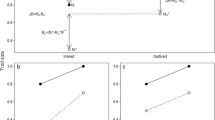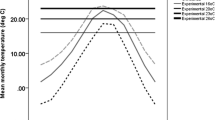Summary
Directional selection for heavier pupa weight in Tribolium castaneum was practiced for 18 generations in two replicates of an inbred line, each separately maintained in small population cages for more than 90 generations. Mutational variance was estimated in two ways, based on Hill's (1982a) prediction equation for response to directional selection where an equilibrium state between effective population size and variation created by new mutation is assumed. Estimates of mutational variance based on response to selection in a selected population and from a sire-offspring regression analysis in an unselected control population were in strong agreement within each replicate population. Significant differences between the two replicates were observed. Estimates of the ratio of mutational variance to environmental variance ranged from 0.0002 to 0.0012, depending upon the assumptions made about effective population sizes maintained in the two replicate lines. Estimates of realized heritability from the 18 generations of selection were 0.23±0.02 and 0.12±0.02 in the two replicates. The results support the hypothesis that mutation may have played a significant role in supplying useful genetic variation for long-continuing response to selection for this trait in experiments reported earlier.
Similar content being viewed by others
References
Barton NH, Turelli M (1987) Adaptive landscapes, genetic distance, and the evaluation of quantitative traits. Genet Res 47:209–216
Bell AE (1981) Direct and correlated response to long term selection in Tribolium. Proc 30th Natl Breeders Roundtable, pp 1–32
Bell AE, Moore CH (1958) Further comparisons of reciprocal recurrent selection with conventional methods of selection for the improvement of quantitative characteristics. Proc 10th Int Genet Congr, pp 2–20
Bulmer MG (1972) The genetic variability of polygenic characters under optimizing selection, mutation and drift. Genet Res 19:17–25
Comstock RE, Enfield FD (1981) Gene number estimation when multiplicative genetic effects are assumed - growth in flour beetles and mice. Theor Appl Genet 59:373–379
Dudley JW (1977) Seventy-six generations of selection for oil and protein percentage in maize. Proc Int Conf Quant Genet, Iowa State University Press, Ames, pp 459–473
Enfield FD (1980) Long term effects of selection: the limits to response. Proc Symp Selection Exp Lab Domestic Animals, Commonwealth Agric Bureau, UK, pp 69–86
Enfield FD (1986) Quantitative genetic variation from new mutations in Tribolium. Proc 3rd World Congr Genet Appl Livestock Prod Lincoln/NE 12:283–294
Enfield FD, Comstock RE, Braskerud O (1966) Selection for pupa weight in Tribolium castaneum. 1. Parameters in base populations. Genetics 54:523–533
Enfield FD, Comstock RE, Goodwill R, Braskerud O (1969) Selection for pupa weight in Tribolium castaneum. 2. Linkage and level of dominance. Genetics 62:849–857
Falconer DS (1960) Introduction to quantitative genetics, 1st edn. Ronald Press, New York
Goodwill R, Enfield FD (1971) Heterozygosity in inbred lines of Tribolium castaneum. Theor Appl Genet 41:5–12
Hill WG (1982a) Rates of change in quantitative traits from fixation of new mutations. Proc Natl Acad Sci USA 79:142–145
Hill WG (1982b) Prediction of response to artificial selection from new mutations. Genet Res 40:255–278
Kaufman P, Enfield FD, Comstock RE (1977) Stabilizing selection for pupa weight in Tribolium castaneum. Genetics 87:327–341
Lande R (1975) The maintenance of genetic variability by mutation in polygenic character with linked loci. Genet Res 26:221–235
Lande R (1983) The response to selection on major and minor mutations affecting a metric trait. Heredity 50:47–65.
Lynch M (1988) The rate of polygenic mutation. Genet Res 51:137–148
Lynch M, Hill WG (1986) Phenotypic evolution by neutral mutation. Evolution 40:915–935
Turelli M (1984) Heritable genetic variation via mutationselection balance. Lerch's zeta meets the abdominal bristle. Theor Popul Biol 25:138–193
Wilson SP, Kyle WH, Bell AE (1963) The effects of mating systems and selection on pupa weight in Tribolium. Genet Res 6:341–351
Yoo BH (1980) Long term selection for a character in large replicated populations of Drosophila melanogaster. 1. Response to selection. Genet Res 35:1–17
Author information
Authors and Affiliations
Additional information
Communicated by K. Sittmann
Rights and permissions
About this article
Cite this article
Enfield, F.D., Braskerud, O. Mutational variance for pupa weight in Tribolium castaneum . Theoret. Appl. Genetics 77, 416–420 (1989). https://doi.org/10.1007/BF00305838
Received:
Accepted:
Issue Date:
DOI: https://doi.org/10.1007/BF00305838




